Announced
Production status
Original name
System
Pros and cons
- Fast speed
- Floating element system
- Maximum magnification of 1:1
- Relies on in-camera autofocus motor
- No focusing distance range limiter
- No focus mode selector
- Quick-Shift Focus System (QFS)
- Dust-proof and water-resistant barrel
- Super Protect (SP) coating
- Compatible with teleconverters
- Has 1 special limited edition
Genres or subjects of photography
Recommended slowest shutter speed when shooting static subjects handheld
HD Pentax-D FA 100mm F/2.8 ED AW Macro
Macro lens • Digital era
Abbreviations
| HD | Multi-layer High Definition coating is applied to the surfaces of lens elements. This anti-reflection coating increases light transmission, eliminates flare and ghosting, and maintains color consistence among all lens models. |
| D FA | Autofocus lens which is optimized for Pentax digital SLR cameras but can be also used on Pentax film SLR cameras. Learn more |
| ED | The lens incorporates low dispersion elements. |
| AW | Dust-proof and water-resistant lens. |
| MACRO | Macro lens. Designed specially for shooting close-ups of small subjects but can be also used in other genres of photography, not necessarily requiring focusing at close distances. Learn more |
Model history
| ■smc Pentax-A 100mm F/2.8 Macro • 1:1 | A | 7 - 7 | 0.31m | ⌀58 | 1985 ● | |
| ■smc Pentax-F 100mm F/2.8 Macro • 1:1 | A | 9 - 8 | 0.31m | ⌀58 | 1987 ● | |
| ■smc Pentax-FA 100mm F/2.8 Macro • 1:1 | A | 9 - 8 | 0.31m | ⌀58 | 1991 ● | |
| ■smc Pentax-D FA 100mm F/2.8 Macro • 1:1 aka Schneider-Kreuznach D-Xenon 100mm F/2.8 Macro | A | 9 - 8 | 0.30m | ⌀49 | 2004 ● | |
| ■smc Pentax-D FA 100mm F/2.8 Macro WR • 1:1 | A | 9 - 8 | 0.30m | ⌀49 | 2009 ● | |
| ■HD Pentax-D FA 100mm F/2.8 ED AW Macro • 1:1 | A | 10 - 8 | 0.30m | ⌀49 | 2022 ● | |
| HD Pentax-D FA 100mm F/2.8 ED AW Macro Silver (300 units) • 1:1 | 2022 ● | |||||
Specification





| Optical design: | |
| 100mm | |
| F/2.8 | |
| 35mm full frame | |
| Pentax K [45.5mm] | |
| 24.4° (35mm full frame) | |
| 10 elements in 8 groups | |
| 1 ED, 2 AD | |
| Floating element system | |
| On Pentax K APS-C [1.53x] cameras: | |
35mm equivalent focal length: | 153mm (in terms of field of view) |
35mm equivalent speed: | F/4.3 (in terms of depth of field) |
Diagonal angle of view: | 16.1° |
| Diaphragm mechanism: | |
Diaphragm type: | Automatic |
Aperture control: | None; the aperture is controlled from the camera |
| 8 (eight) | |
| Focusing: | |
| 0.303m | |
| 0.13m | |
| 1:1 | |
Focusing modes: | Autofocus, manual focus |
Autofocus motor: | In-camera motor |
Manual focus control: | Focusing ring |
Focus mode selector: | None; focusing mode is set from the camera |
Quick-Shift Focus System (QFS): | Yes |
| Shake Reduction (SR): | |
| - | |
| Physical characteristics: | |
| 348g | |
| ⌀65×80.5mm | |
| Dust-proof and water-resistant barrel | |
| Yes | |
| Accessories: | |
| Screw-type 49mm | |
| PH-RBE49 - Bayonet-type round | |
| HD Pentax-DA 1.4X AF Rear Converter AW → 140mm F/3.9 |
Source of data
- Manufacturer's technical data.
Manufacturer description
PARSIPPANY, N.J., Oct. 19, 2022 /PRNewswire/ -- Ricoh Imaging Americas Corporation today announced the HD PENTAX-D FA MACRO 100mm F2.8ED AW lens—the first PENTAX macro lens to feature All Weather (AW) dustproof, weather-resistant construction. Incorporating a new optical design developed using the latest optical design technologies, the lens optimizes image resolution and contrast, even at open aperture, and delivers clear, high-quality images.
When mounted on a dustproof, weather-resistant PENTAX digital SLR camera body, the new HD PENTAX-D FA MACRO 100mm F2.8ED AW lens creates a highly dependable, durable imaging system that performs superbly in demanding shooting conditions — such as snow, mist, rain, or in locations prone to splashing or spraying water.
Despite the new optical design and AW construction, the new lens is nearly as compact as its predecessor (the smc PENTAX-D FA MACRO 100mm F2.8 WR). It features a new exterior design and incorporates the PENTAX-original Quick-Shift Focus System, enabling the photographer to instantly shift the focus mode from auto to manual after the subject has been captured in focus by the camera's autofocus system.
In addition to the standard black model, the HD PENTAX-D FA MACRO 100mm F2.8ED AW lens will also be available in a special-edition silver model — limited to just 300 units worldwide.
| Main features of the HD PENTAX-D FA MACRO 100mmF2.8ED AW |
1. Exceptional imaging performance made possible by the latest optical design technologies
The lens incorporates one ED (Extra-low Dispersion) glass optical element and two Anomalous Dispersion glass optical elements to compensate for various aberrations and minimize the generation of the unwanted purple fringe effect. This is coupled with the high-grade, multi-layer HD (High Definition) Coating, which significantly reduces average reflectance in the visible ray spectrum to less than 50% compared to conventional models, and the innovative FREE (Fixed Rear Element Extension) focusing system. All together, these technologies effectively reduce the generation of flare and ghost images over the entire focus range — from minimum focusing distance to infinity — and deliver clear, high-quality images. The lens also provides life-size magnification in close-range shooting to capture dramatic, fine-detailed close-up images.
2. Dustproof, weather-resistant AW construction for exceptional outdoor shooting reliability
Ready for adverse weather conditions, the lens features dustproof, weather-resistant AW (All Weather) construction for the first time in a PENTAX macro lens. This dependable construction prevents the intrusion of dust and moisture into the lens body, using six sealing parts to optimize airtight performance. When mounted on a dustproof, weather-resistant PENTAX digital SLR camera body, it creates a highly dependable, durable imaging system that performs superbly in demanding shooting conditions — such as snow, mist, rain, or in locations prone to splashing or spraying water.
3. Exclusive exterior design and outstanding operability
The lens has an attractive, stylish appearance, with metallic exterior parts meticulously machined from high-grade aluminum. Its focus ring features the PENTAX-original Quick-Shift Focus System, which allows the photographer to instantly shift the focus mode from auto to manual after the subject has been captured in focus by the camera's autofocus system. This single-action operation assures a smooth, comfortable focus-mode switching maneuver during manual-focus shooting for dramatically improved operability.
4. Compact, lightweight design for superb maneuverability
Despite the improved imaging power made possible by the new optical design and outstanding AW construction, the lens is nearly as compact and lightweight as the smc PENTAX-D FA MACRO 100mm F2.8 WR (launched in December 2009), with outstanding weight distribution, ergonomics and maneuverability.
5. Other features
- A working distance of 5.1 inches (13 centimeters), at life-size magnification, to facilitate the shooting of typically uncooperative subjects, such as insects
- Individual serial number assigned to each lens: black model starts at 0000001, the silver model starts at 1000001
- Circular diaphragm to produce a natural, beautiful bokeh (defocus) effect from open aperture to F5.6, while minimizing the streaking effect of point light sources
- SP(Super Protect)Coating applied to the front optical element to keep the front surface free of dust or stains
Pentax-D FA series
The fifth generation of autofocus lenses designed for Pentax digital SLR cameras, but compatible with Pentax 35mm film SLR cameras. Introduced after the Pentax *ist D in 2004.
- Lens barrels made from engineering plastic;
- Weather-resistant designs;
- Do not have an aperture ring. The aperture is controlled from the camera;
- Automatic focusing using in-lens motor (except for macro lenses which rely on in-camera motor);
- Quick-Shift Focus System with Pentax digital SLR cameras.
Travellers' choice
- Fast speed (F/2.8)
- Lightweight (348g)
- Dust-proof and water-resistant barrel
- Super Protect (SP) coating
From the editor
Ricoh claims that the lens has a new optical design, however if you compare the optical formulas of the HD D FA 100/2.8 ED AW Macro (2022) and the smc D FA 100/2.8 WR Macro (2009), you will see that the new lens is actually based on the 2009 design where the second element was replaced with a doublet, plus one element became ED and the other two became AD elements to eliminate lateral chromatic aberration (so called purple fringing), a big problem with the 2009 design. It took Ricoh a whole 13 years to fix this.
Having slightly changed the optical design, Ricoh decided not to change the mechanics: the lens still relies on the autofocus motor built into the camera, and there is still no focusing distance range limiter, which is somewhat disappointing, since the rotation angle of the focusing ring is about 270 degrees.
What's more, the lens is exactly the same size as the 2009 model and accepts the same 49mm screw-type filters, as well as the lens hood PH-RBE49.
For the Pentax system, the lens has excellent functionality, and using the camera's built-in motor for automatic focusing is not a significant drawback for a macro lens, since when shooting macro, experienced photographers still prefer to focus manually to get the desired result.
For those who already have the smc D FA 100/2.8 WR Macro (2009), it makes sense to upgrade if the purple fringing really annoys you and you need more serious dust and moisture protection.
Compared to other macro lenses in the Pentax K system
- Weather sealed, along with the smc Pentax-D FA 100/2.8 Macro WR
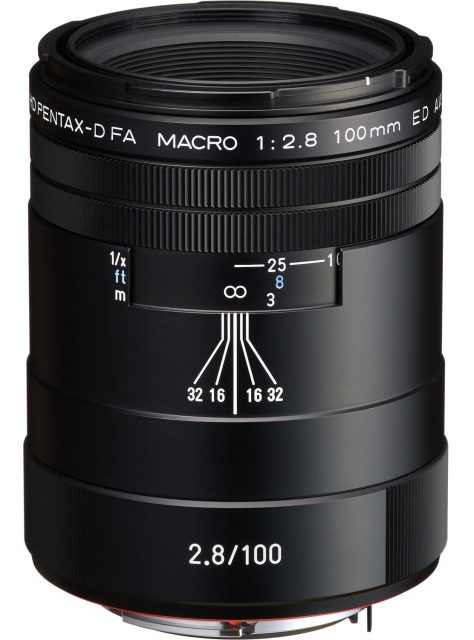
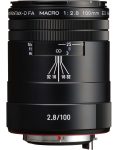


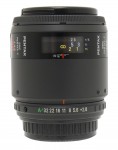

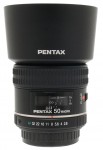



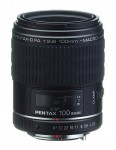
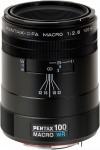
![smc Pentax-FA* 200mm F/4 ED [IF] Macro](https://lens-db.com/wp-content/uploads/2012/07/2004macro-1-91x150.jpg)
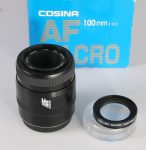

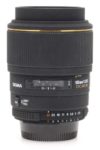


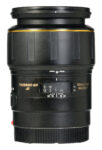


![Tokina AT-X Macro AF 100mm F/2.8 [IF]](https://lens-db.com/wp-content/uploads/2012/09/tokina-m100-01-97x150.jpg)